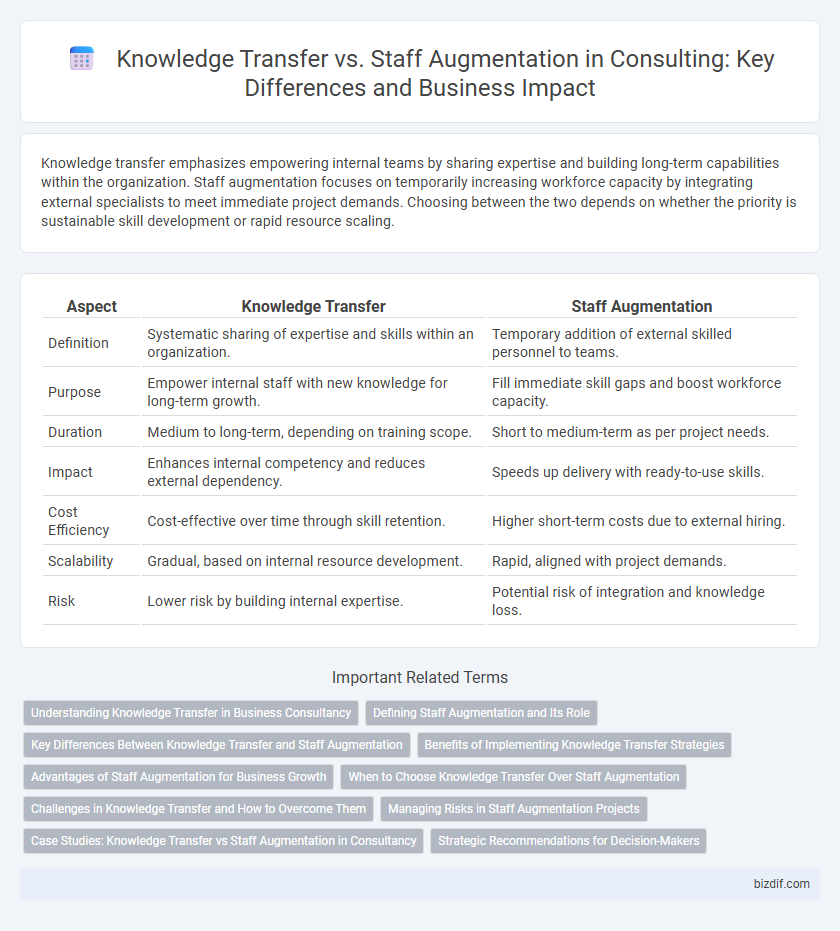Knowledge transfer emphasizes empowering internal teams by sharing expertise and building long-term capabilities within the organization. Staff augmentation focuses on temporarily increasing workforce capacity by integrating external specialists to meet immediate project demands. Choosing between the two depends on whether the priority is sustainable skill development or rapid resource scaling.
Table of Comparison
| Aspect | Knowledge Transfer | Staff Augmentation |
|---|---|---|
| Definition | Systematic sharing of expertise and skills within an organization. | Temporary addition of external skilled personnel to teams. |
| Purpose | Empower internal staff with new knowledge for long-term growth. | Fill immediate skill gaps and boost workforce capacity. |
| Duration | Medium to long-term, depending on training scope. | Short to medium-term as per project needs. |
| Impact | Enhances internal competency and reduces external dependency. | Speeds up delivery with ready-to-use skills. |
| Cost Efficiency | Cost-effective over time through skill retention. | Higher short-term costs due to external hiring. |
| Scalability | Gradual, based on internal resource development. | Rapid, aligned with project demands. |
| Risk | Lower risk by building internal expertise. | Potential risk of integration and knowledge loss. |
Understanding Knowledge Transfer in Business Consultancy
Knowledge Transfer in business consultancy involves the systematic process of passing expertise, insights, and skills from consultants to the client's internal team to ensure sustainable growth and improved operational efficiency. This approach contrasts with Staff Augmentation, where external professionals temporarily fill skill gaps without necessarily imparting critical knowledge for long-term independence. Emphasizing Knowledge Transfer enables organizations to build internal capabilities that reduce reliance on external consultants and foster continuous innovation.
Defining Staff Augmentation and Its Role
Staff augmentation is a consulting strategy that involves temporarily adding skilled professionals to an existing team to fill specific knowledge or resource gaps. This approach enables organizations to scale their workforce quickly while maintaining control over project management and knowledge retention. It plays a critical role in addressing immediate skill shortages without the long-term commitments associated with hiring full-time employees.
Key Differences Between Knowledge Transfer and Staff Augmentation
Knowledge transfer involves sharing expertise and insights from consultants to internal teams, ensuring long-term capability development and sustainability within an organization. Staff augmentation provides temporary skilled personnel to fill immediate resource gaps without necessarily transferring knowledge or building internal competencies. Key differences lie in the strategic focus: knowledge transfer emphasizes skill-building and autonomy, while staff augmentation centers on quick resource scaling and execution support.
Benefits of Implementing Knowledge Transfer Strategies
Implementing knowledge transfer strategies enhances organizational resilience by preserving critical expertise and reducing dependency on individual employees. It fosters continuous learning and skill development, accelerating project delivery and boosting overall team productivity. Effective knowledge transfer minimizes onboarding time for new hires while ensuring consistent quality and innovation across consultancy projects.
Advantages of Staff Augmentation for Business Growth
Staff augmentation offers businesses flexible access to specialized skills, enabling rapid scaling of project teams without long-term hiring commitments. It reduces recruitment costs and accelerates time-to-market by integrating experts who seamlessly align with existing workflows. This approach enhances productivity and innovation, directly contributing to sustainable business growth.
When to Choose Knowledge Transfer Over Staff Augmentation
Choose knowledge transfer over staff augmentation when long-term capability building and organizational independence are priorities, enabling internal teams to sustain expertise and reduce future external dependencies. Knowledge transfer is ideal for complex projects requiring deep understanding, where embedding skills within the company ensures continuous innovation and resilience. Staff augmentation suits short-term resource gaps, but knowledge transfer fosters sustainable growth and enhances internal competence.
Challenges in Knowledge Transfer and How to Overcome Them
Challenges in knowledge transfer often include miscommunication, lack of documentation, and resistance to change, which can hinder project continuity and efficiency. Overcoming these obstacles requires implementing structured training programs, fostering an open communication culture, and utilizing technology platforms for effective knowledge management. Ensuring clear roles and accountability enhances retention and smooth transition between consulting teams and in-house staff.
Managing Risks in Staff Augmentation Projects
Managing risks in staff augmentation projects requires clear communication of project goals and expectations to temporary staff, ensuring alignment with internal teams. Implementing thorough vetting processes for augmented personnel minimizes skill mismatches and potential security breaches. Continuous monitoring and feedback loops help identify issues early, reducing project delays and maintaining quality standards.
Case Studies: Knowledge Transfer vs Staff Augmentation in Consultancy
Case studies in consultancy reveal that knowledge transfer enhances long-term organizational capability by embedding expertise within the client's team, while staff augmentation offers immediate resource scalability without a sustained skill uplift. Analysis of projects shows knowledge transfer leads to improved innovation and process optimization as internal teams gain critical insights and best practices. Conversely, staff augmentation typically supports short-term project demands, delivering specialized skills that address immediate challenges but often results in dependency on external consultants.
Strategic Recommendations for Decision-Makers
Knowledge transfer ensures sustainable expertise development within organizations, empowering teams to independently manage complex projects over time. Staff augmentation offers immediate access to specialized skills, enhancing project flexibility and accelerating delivery without long-term commitments. Decision-makers should evaluate project scope, timeline, and knowledge retention goals to balance short-term capacity needs with long-term organizational growth.
Knowledge Transfer vs Staff Augmentation Infographic

 bizdif.com
bizdif.com